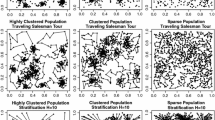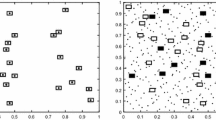Abstract
Some environmental studies use non-probabilistic sampling designs to draw samples from spatially distributed populations. Unfortunately, these samples can be difficult to analyse statistically and can give biased estimates of population characteristics. Spatially balanced sampling designs are probabilistic designs that spread the sampling effort evenly over the resource. These designs are particularly useful for environmental sampling because they produce good-sample coverage over the resource, they have precise design-based estimators and they can potentially reduce the sampling cost. The most popular spatially balanced design is Generalized Random Tessellation Stratified (GRTS), which has many desirable features including a spatially balanced sample, design-based estimators and the ability to select spatially balanced oversamples. This article considers the popularity of spatially balanced sampling, reviews several spatially balanced sampling designs and shows how these designs can be implemented in the statistical programming language R. We hope to increase the visibility of spatially balanced sampling and encourage environmental scientists to use these designs.


Similar content being viewed by others
References
Albert, C. H., Yoccoz, N. G., Edwards, T. C., et al. (2010). Sampling in ecology and evolution–bridging the gap between theory and practice. Ecography, 33, 1028–1037.
Barabesi, L., & Franceschi, S. (2011). Sampling properties of spatial total estimators under tessellation stratified designs. Environmetrics, 22, 271–278.
Benedetti, R., & Piersimoni, F. (2017). A spatially balanced design with probability function proportional to the within sample distance. Biometrical Journal, 59, 1067–1084.
Benedetti, R., Piersimoni, F., & Postiglione, P. (2015). Sampling spatial units for agricultural surveys. Springer.
Benedetti, R., Piersimoni, F., & Postiglione, P. (2017). Spatially balanced sampling: a review and a reappraisal. International Statistical Review, 85, 439–454.
Bondesson, L., & Thorburn, D. (2008). A list sequential sampling method suitable for real-time sampling. Scandinavian Journal of Statistics, 35, 466–483.
Brown, J. A., Robertson, B. L., & McDonald, T. (2015). Spatially balanced sampling: application to environmental surveys. Spatial Statistic Conference, 27, 6–9. https://doi.org/10.1016/j.proenv.2015.07.108.
Christianson, D. S., & Kaufman, C. G. (2016). Effects of sample design and landscape features on a measure of environmental heterogeneity. Methods in Ecology and Evolution, 7, 770–782. https://doi.org/10.1111/2041-210X.12539.
Conn, P. B., Moreland, E. E., Regehr, E. V., Richmond, E. L., Cameron, M. F., & Boveng, P. L. (2016). Using simulation to evaluate wildlife survey designs: polar bears and seals in the Chukchi Sea. Royal Society Open Science, 3, 150561. https://doi.org/10.1098/rsos.150561.
Dickson, M. M., Benedetti, R., Giuliani, D., & Espa, G. (2014). The use of spatial sampling designs in business surveys. Open Journal of Statistics, 4, 345–354. https://doi.org/10.4236/ojs.2014.45034.
Foster, S. D. (2016). MBHdesign: spatial designs for ecological and environmental surveys. R package version, 1, 61.
Foster, S. D., Hosack, G. R., Hill, N. A., Barrett, N. S., & Lucieer, V. L. (2014). Choosing between strategies for designing surveys: autonomous underwater vehicles. Methods in Ecology and Evolution, 5, 287–297.
Grafström, A. (2012). Spatially correlated Poisson sampling. Journal of Statistical Planning and Inference, 142, 139–147. https://doi.org/10.1016/j.jspi.2011.07.003.
Grafström A, Lisic J (2016) BalancedSampling: balanced and spatially balanced sampling [online]. R package version 1.5. 2
Grafström, A., & Lundström, N. L. (2013). Why well spread probability samples are balanced. Open Journal of Statistics, 3, 36–41.
Grafström, A., & Matei, A. (2018). Spatially balanced sampling of continuous populations. Scandinavian Journal of Statistics 45:792–805
Grafström, A., & Schelin, L. (2014). How to select representative samples. Scandinavian Journal of Statistics, 41, 277–290.
Grafström, A., & Tillé, Y. (2013). Doubly balanced spatial sampling with spreading and restitution of auxiliary totals. Environmetrics, 24, 120–131.
Grafström, A., Lundström, N. L., & Schelin, L. (2012). Spatially balanced sampling through the pivotal method. Biometrics, 68, 514–520.
Grafström, A., Zhao, X., Nylander, M., & Petersson, H. (2017). A new sampling strategy for forest inventories applied to the temporary clusters of the Swedish national forest inventory. Canadian Journal of Forest Research, 47, 1161–1167.
Haining, R. P. (2003). Spatial data analysis: theory and practice. United Kingdom: Cambridge University Press.
Halton, J. H. (1960). On the efficiency of certain quasi-random sequences of points in evaluating multi-dimensional integrals. Numerische Mathematik, 2, 84–90.
Keinath, D. A., & NRA B.C. (2016). Bat population monitoring of Bighorn Canyon National Recreation Area: 2015 progress report. 3. pp
Kenkel, N., Juhász-Nagy, P., & Podani, J. (1990). On sampling procedures in population and community ecology. In: Prog Theor Veg Sci 83:195–207. https://doi.org/10.1007/BF00031692
Kermorvant, C., Caill-Milly, N., D’Amico, F., et al. (2017). Optimization of a survey using spatially balanced sampling: a single-year application of clam monitoring in the Arcachon Bay (SW France). Aquatic Living Resources, 30, 37.
Kermorvant, C., Caill-Milly, N., Bru, N., & D’Amico, F. (2019). Optimizing cost-efficiency of long term monitoring programs by using spatially balanced sampling designs: the case of manila clams in Arcachon bay. Ecological Informatics, 49, 32–39. https://doi.org/10.1016/j.ecoinf.2018.11.005.
Kincaid, T. M., Olsen, A. R. (2015). spsurvey: Spatial Survey Design and Analysis. R package version 3.1. http://www.epa.gov/nheerl/arm/.
Levy, P. S., & Lemeshow, S. (2013). Sampling of populations: methods and applications. New Jersey: John Wiley & Sons.
Liu, X. C., & Chen, Z. (2018). Statistical analysis and sampling standards for maintenance management quality assurance (MMQA). (No. MPC 18-350). Mountain Plains Consortium
MacKenzie, D. I. (2006). Occupancy estimation and modeling: inferring patterns and dynamics of species occurrence. Academic Press.
McDonald, T. (2016). SDraw: spatially balanced sample draws for spatial objects. R package version 2.1.8. https://CRAN.R-project.org/package=SDraw
McGarvey, R., Burch, P., & Matthews, J. M. (2016). Precision of systematic and random sampling in clustered populations: habitat patches and aggregating organisms. Ecological Applications, 26, 233–248.
Messer, J. J., Linthurst, R. A., & Overton, W. S. (1991). An EPA program for monitoring ecological status and trends. Environmental Monitoring and Assessment, 17, 67–78.
Oklahoma Water Resources Board. (2013). The statewide stream/river probabilistic monitoring network-final report. 3800 N (p. 73118). Oklahoma City: Classen.
Olsen, A., Kincaid, T., & Payton, Q. (2012). Spatially balanced survey designs for natural resources. In: Design and analysis of long-term ecological monitoring studies (pp 126–150). New York: Cambridge University Press.
Pantalone, Benedetti R., & Piersimoni, F. (2019). Spbsampling: spatially balanced sampling. [online]. R package version 1.2.0
R Core Team. (2014). R: A language and environment for statistical computing. Vienna, Austria: R Foundation for Statistical Computing.
Robertson, B., Brown, J., McDonald, T., & Jaksons, P. (2013). BAS: balanced acceptance sampling of natural resources. Biometrics, 69, 776–784.
Robertson, B., McDonald, T., Price, C., & Brown, J. (2017). A modification of balanced acceptance sampling. Statistics & Probability Letters, 129, 107–112.
Robertson, B., McDonald, T., Price, C., & Brown, J. (2018). Halton iterative partitioning: spatially balanced sampling via partitioning. Environmental and Ecological Statistics, 25:1–19.https://doi.org/10.1007/s10651-018-0406-6
Sica, G. T. (2006). Bias in research studies 1. Radiology, 238, 780–789.
Smith, A. N., Anderson, M. J., & Pawley, M. D. (2017). Could ecologists be more random? Straightforward alternatives to haphazard spatial sampling. Ecography, 40, 1251–1255. https://doi.org/10.1111/ecog.02821.
Stehman, S. V. (2009). Sampling designs for accuracy assessment of land cover. International Journal of Remote Sensing, 30, 5243–5272.
Stehman, S. V., & Overton, W. S. (1994). 9 Environmental sampling and monitoring. In: Handbook of Statistics (pp 263–306). United Kingdom: Elsevier.
Stevens, D. L., & Olsen, A. R. (2003). Variance estimation for spatially balanced samples of environmental resources. Environmetrics, 14, 593–610.
Stevens, D. L., & Olsen, A. R. (2004). Spatially balanced sampling of natural resources. Journal of the American Statistical Association, 99, 262–278.
Theobald, D. M., Stevens, D. L., Jr., White, D., Urquhart, N. S., Olsen, A. R., & Norman, J. B. (2007). Using GIS to generate spatially balanced random survey designs for natural resource applications. Environmental Management, 40, 134–146.
van Dam-Bates, P., Gansell, O., & Robertson, B. (2018). Using balanced acceptance sampling as a master sample for environmental surveys. Methods in Ecology and Evolution, 9:1718–1726. https://doi.org/10.1111/2041-210X.13003.
Wang, J-F, Jiang, C-S, Hu, M-G, et al. (2012). Design-based spatial sampling: Theory and implementation. Environmental Modelling and Software, 40, 280–288.
Acknowledgements
We thank Jennifer Brown, Trent McDonald, Anton Grafström and Roberto Benedetti and anonymous referees for valuable comments that improved this paper.
Funding
This work was supported by “Communauté d’Agglomération Pays Basque – Euskal Hirigune Elkargoa” through a thesis grant.
Author information
Authors and Affiliations
Corresponding author
Additional information
Publisher’s note
Springer Nature remains neutral with regard to jurisdictional claims in published maps and institutional affiliations.
Electronic supplementary material
ESM 1
(PDF 247 kb)
Rights and permissions
About this article
Cite this article
Kermorvant, C., D’Amico, F., Bru, N. et al. Spatially balanced sampling designs for environmental surveys. Environ Monit Assess 191, 524 (2019). https://doi.org/10.1007/s10661-019-7666-y
Received:
Accepted:
Published:
DOI: https://doi.org/10.1007/s10661-019-7666-y




